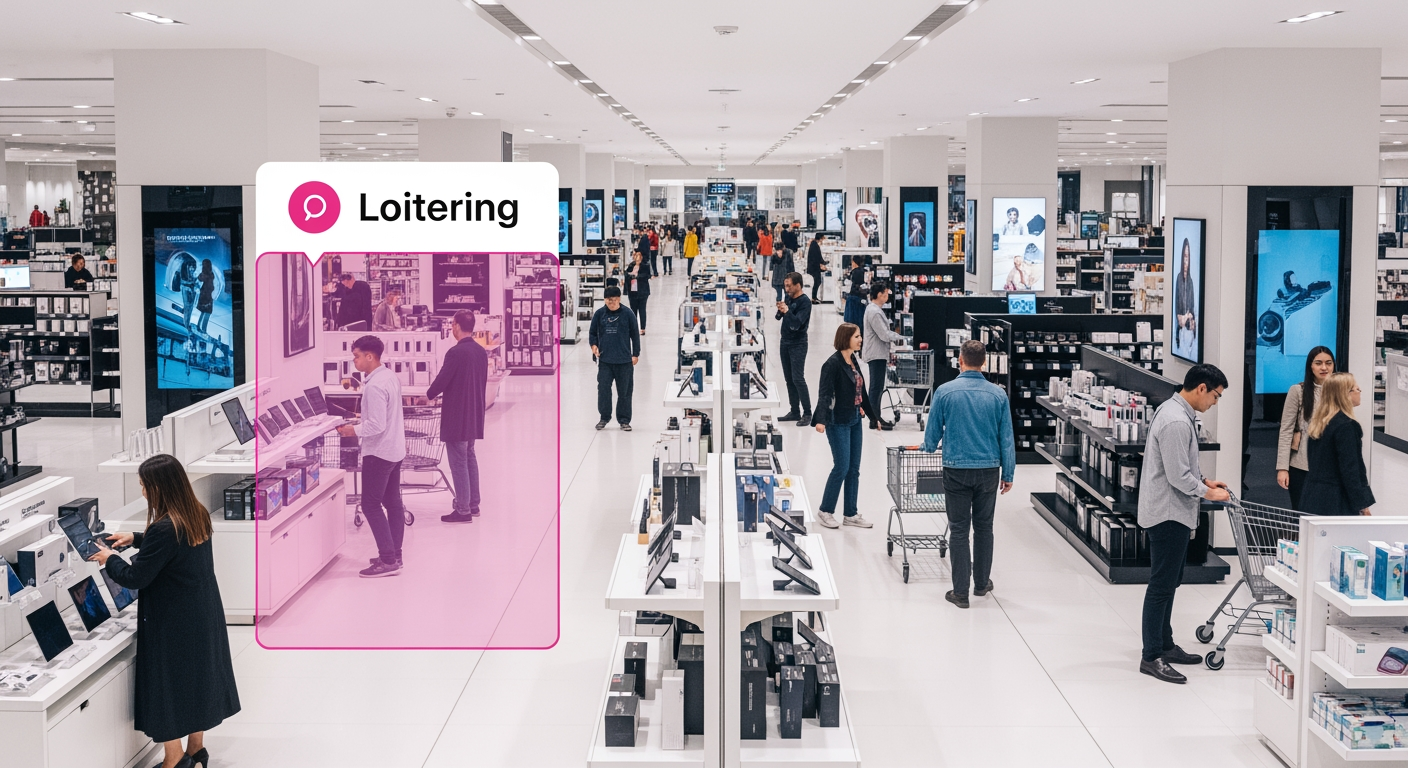In 2025, retail is a data-driven environment. Shoplifting, employee fraud, and operational inefficiencies cost the global retail sector billions of dollars annually—a number that keeps growing. Traditional camera systems struggle with these modern obstacles: they’re reactive, hard to search, and add little value beyond basic monitoring. Today’s retailers need more than just eyes on the aisles. They need AI cameras—intelligent, always-on systems that deliver valuable data, automate loss mitigation, and help frontline teams make smarter decisions.
Whether you manage a single store or a nationwide chain, the right AI camera system can reshape your approach to security, staffing, and customer experience. But with so many vendors promising everything from “industrial monitoring” to “video AI analytics” and “factory safety,” how do you choose the right fit? This guide compares the top 7 AI cameras for retail in 2025—breaking down their features, deployment models, costs, and use cases to help you make a confident, long-term investment.
At-a-Glance: Top 7 AI Cameras for Retail
System Name |
Best For |
Key Features |
Integration |
Flexibility |
Storage Type |
Notable Pros / Cons |
|---|---|---|---|---|---|---|
Spot AI |
Fast, scalable insights for any size |
AI search, real-time alerts, video analytics, hybrid cloud/on-prem, system typically live in under a week |
Works with most IP cameras, open API |
Camera-agnostic, multi-site, easy expansion |
Hybrid (cloud + local) |
Pros: Fast setup, intuitive dashboard, low TCO |
Hanwha Vision |
Reducing shrink + in-store marketing |
Dual-mode displays (ads + live view), deep learning analytics, people counting, audio warnings |
IP-based, some 3rd party |
Focused on mid-large, premium |
On-premise w/cloud mgmt |
Pros: Marketing + security, strong analytics |
Axis Comm. |
High-security, compliance-focused |
Edge analytics (object/sound), FIPS 140-3 encryption, vandal-proof, people counting |
Open API, POS integration (complex) |
Hybrid, multi-site, robust hardware |
Hybrid (edge + cloud) |
Pros: Cybersecurity, edge processing |
Hikvision |
Enterprise checkout & shrink control |
ScanWatch checkout AI, POS sync, heatmaps, multi-site dashboards |
API to major checkouts |
Centralized, but HW-locked |
Cloud + edge |
Pros: Checkout loss mitigation |
Dahua |
Boutique retail, sales optimization |
VIP recognition, sales conversion analytics, demographic insights |
Basic API, limited POS |
Best for small chains |
On-premise, cloud optional |
Pros: Sales insights, affordable entry |
Avigilon |
Large, complex retail environments |
Appearance Search, anomaly detection, POS integration, advanced forensic tools |
Proprietary, some POS |
Large-scale, but HW-locked |
On-premise, cloud assist |
Pros: Powerful search, anomaly alerts |
Mobotix |
SMBs, energy savings, basic AI |
Occupancy/thermal analytics, open API, audio event detection |
Open API, any system |
Flexible, edge-first |
Edge/on-premise |
Pros: Low cost, open platform |
Deep Dives: 2025’s Leading AI Camera Systems for Retail
Below, we break down each solution with the same lens: core technology, deployment, costs, integration, and use cases.
Spot AI
Core Technology Capabilities and Specifications:
Spot AI provides a Unified Video AI platform engineered for operational efficiency with AI cameras. It combines an on-site intelligent video recorder with secure cloud storage, supports most ONVIF-compliant IP cameras, and offers AI-powered video analysis—search, real-time alerts, and people counting—all through an intuitive dashboard.Implementation Requirements and Timeline:
Spot AI is designed for rapid deployment: most retail locations are live in under a week. The system is plug-and-play, requiring minimal IT intervention. Existing cameras can be reused, or new ones added as needed. No proprietary hardware lock-in.Total Cost Considerations:
Spot AI’s hybrid model minimizes upfront investment by leveraging existing infrastructure. Subscription pricing includes software, updates, and support, with no hidden maintenance or upgrade fees. Total cost of ownership (TCO) is typically 30–50% lower than legacy systems due to reduced hardware and labor needs.Integration Capabilities with Existing Systems:
Open API and broad camera compatibility make integration simple—whether it’s POS, inventory, or HR systems. Multi-site dashboards let managers see all locations at once.Target Use Cases and Industry Applications:
Ideal for proactive loss mitigation, queue management, customer analytics, and safety compliance. Spot AI’s platform empowers frontline teams to deter incidents before they happen, resolve them in seconds when they do, and optimize staffing based on real-world traffic patterns.
Hanwha Vision
Core Technology Capabilities and Specifications:
Hanwha Vision’s AI Public View Monitors (PVMs) uniquely combine monitoring and marketing. Deep learning analytics provide people counting, loitering detection, and heatmaps. Dual-mode displays switch from ads to live video when human activity is detected.Implementation Requirements and Timeline:
Deployment is typically on-premise, with cloud management options. Installation requires dedicated display space and integration with store audio for real-time warnings.Total Cost Considerations:
Premium pricing reflects advanced features and display hardware. ROI is driven by theft reduction and increased marketing efficiency, but upfront costs are higher than most competitors.Integration Capabilities with Existing Systems:
IP-based integration; can connect to some third-party systems for analytics, though deep integrations (e.g., POS) may require custom work.Target Use Cases and Industry Applications:
Best for mid-to-large retailers who want to blend loss mitigation with customer engagement—think grocery, electronics, and department stores.
Axis Communications
Core Technology Capabilities and Specifications:
Axis’s ARTPEC-9-powered AI cameras offer 8MP video, forensic WDR, and edge-based analytics for object and sound classification. FIPS 140-3 Level 3 encryption ensures top-tier cybersecurity.Implementation Requirements and Timeline:
Hybrid deployment—edge analytics with optional cloud storage. Installation is durable (vandal-resistant), but POS integration can be complex and time-intensive.Total Cost Considerations:
$500–$1,000 per camera, plus integration costs. Ongoing software and support fees apply.Integration Capabilities with Existing Systems:
Open API allows for integration with third-party software and POS, but may require custom development for full functionality.Target Use Cases and Industry Applications:
High-security retail, pharmacies, luxury goods—where compliance, privacy, and advanced analytics are critical.
Hikvision
Core Technology Capabilities and Specifications:
Hikvision’s ScanWatch integrates computer vision with checkout cameras to detect unscanned items and employee-customer collusion. Includes heatmapping, real-time POS sync, and attribute-based detailed search.Implementation Requirements and Timeline:
Cloud-based deployment with edge processing. Requires Hikvision-specific hardware, limiting flexibility for stores with existing camera fleets.Total Cost Considerations:
Subscription model per camera/node. Hardware dependency increases total cost for retrofits.Integration Capabilities with Existing Systems:
API integrations with major checkout/POS manufacturers. Centralized dashboards for multi-store management.Target Use Cases and Industry Applications:
Enterprise retailers focused on shrink reduction at self-checkouts and optimizing store layouts.
Dahua Technology
Core Technology Capabilities and Specifications:
Dahua’s Smart Retail Solution offers AI-driven demographic analysis, dwell time, queue monitoring, and VIP recognition for personalized service.Implementation Requirements and Timeline:
On-premise deployment with optional cloud analytics. Setup is straightforward for boutiques and small chains.Total Cost Considerations:
Tiered pricing: starts at $199/camera for basic analytics, with additional modules available.Integration Capabilities with Existing Systems:
Basic API for integration; limited POS and inventory system compatibility.Target Use Cases and Industry Applications:
Specialty and boutique retailers looking to optimize sales conversion and customer experience.
Avigilon (Motorola Solutions)
Core Technology Capabilities and Specifications:
Avigilon’s Appearance Search uses AI to analyze clothing and movement patterns, enabling rapid, detailed search. Unusual Motion Detection flags anomalies and integrates with POS for exception reporting.Implementation Requirements and Timeline:
Requires on-premise servers and proprietary cameras. Hardware investment is substantial; setup best suited for large, complex environments.Total Cost Considerations:
Entry costs exceed $20,000 for a 10-camera setup, plus server and ongoing support fees.Integration Capabilities with Existing Systems:
POS integration available; limited third-party camera compatibility.Target Use Cases and Industry Applications:
Large retailers with complex layouts and high-value inventory.
Mobotix
Core Technology Capabilities and Specifications:
Mobotix focuses on automation and cost reduction. AI cameras offer thermal imaging, occupancy monitoring, and basic audio analytics (e.g., glass break detection).Implementation Requirements and Timeline:
Edge-based deployment—no cloud dependency. Open API enables integration with third-party systems.Total Cost Considerations:
Competitive pricing: $150–$300 per camera. Minimal ongoing costs.Integration Capabilities with Existing Systems:
Open platform; works with most existing infrastructure.Target Use Cases and Industry Applications:
SMBs, convenience stores, and retailers needing basic AI features and energy monitoring.
Ready to Improve Your Retail Operations? Book a Demo with Spot AI
The right AI camera system unlocks operational efficiency, reduces shrink, and enables your team to make smarter, faster decisions. Spot AI stands out with camera-agnostic flexibility, rapid deployment, and video AI that is intuitive and easy to use. Book a demo with our experts today and see how our Video AI platform can elevate your security, sales, and customer experience.
Frequently Asked Questions
What are AI cameras for retail, and how are they different from traditional camera systems?
AI cameras for retail use computer vision and machine learning to analyze video in real time. Unlike traditional camera systems, which only records footage, AI cameras detect suspicious behavior, count people, analyze dwell times, and deliver swift alerts—turning video into useful information.
How do AI cameras improve operational efficiency in retail environments?
AI cameras automate routine monitoring, optimize staffing based on real-time traffic, and help reduce checkout wait times.
Are AI camera systems complex to integrate with existing retail technology?
Most leading systems now offer open APIs and camera-agnostic designs. Solutions like Spot AI work with your existing IP cameras and can connect to POS, inventory, and HR systems. Some legacy vendors require proprietary hardware, so check compatibility before investing.
How do AI cameras address privacy and compliance concerns?
Top vendors comply with data privacy regulations by encrypting video, enforcing role-based access, and offering transparent data policies. Features like Edge Vault (Axis) and hybrid cloud/local storage (Spot AI) help retailers balance security needs with customer privacy.
About the author
Amrish Kapoor is VP Technology at Spot AI, where he leads system architecture and AI innovation for advanced video AI. With over a decade of experience in cloud infrastructure, machine learning, and operational technology for industrial and retail environments, Amrish specializes in designing scalable, secure, and user-friendly AI camera platforms that enable frontline teams to work smarter and safer.

























.png)
.png)
.png)